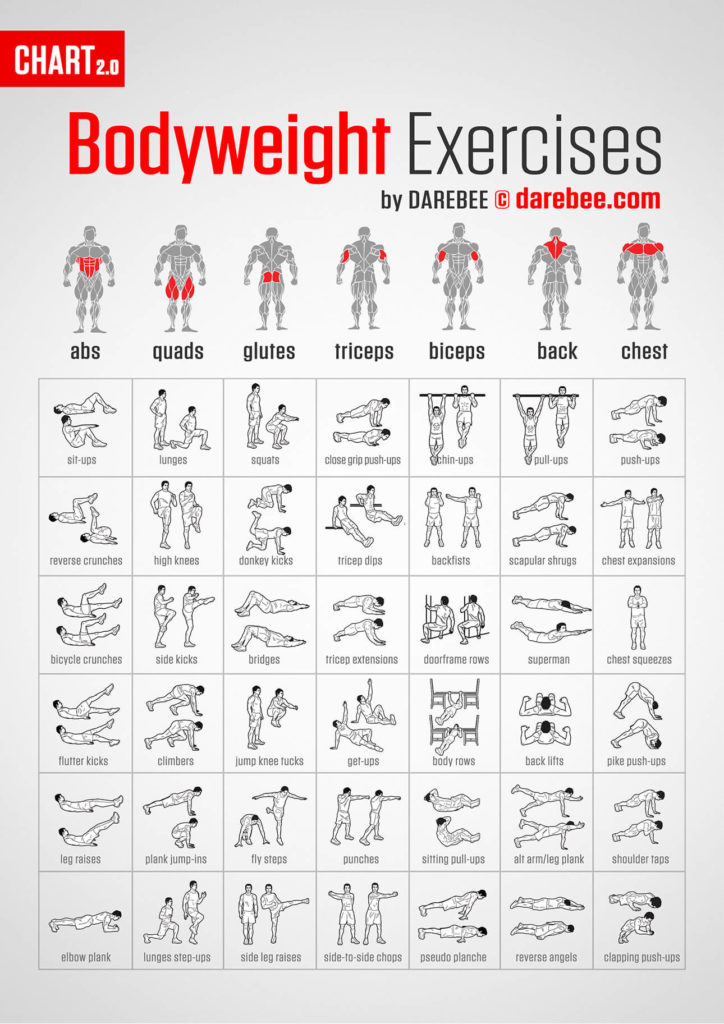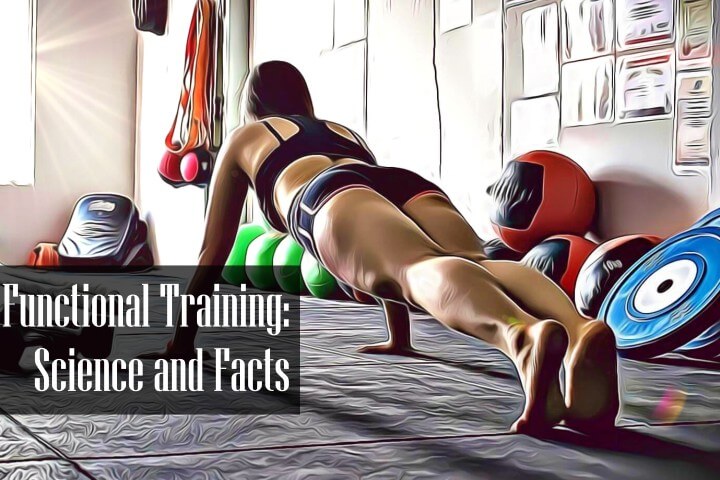What is functional training workout? I understand why you are curious; functional training actually sounds pretty cool!
The fact is:
Due to their excellent results, functional training has, over the years, become one of the most used forms of exercise within the fitness world.
High-level athletes have for many years regarded functional training as a vital part of their fitness program, helping them build solid strength that is actually USEFUL.
And useful is the key here. Stay with me, and in the following paragraphs, I’ll explain why functional training can also work for you!
Contents
- 1 What is Functional Training Workout: The Short Version
- 2 8 Killer Benefits of Functional Training
- 3 At-Home Functional Exercises to Build Massive Strength
- 4 15-Minute Functional Training Program For Beginners
- 5 Functional Training Exercises List
- 6 Final Words: What is Functional Strength Training
- 7 Other Helpful Resources
What is Functional Training Workout: The Short Version
First of all, we need to know how functional training works on our bodies to understand why it is so beneficial.
The main idea is to make you and your body experts in the movements that you are designed to perform. You will achieve this by focusing mostly on training your core muscles located in the lower back and abdomen…
“Functional training is a classification of exercise which involves training the body for the activities performed in daily life.”
Reference: wikipedia.com – Functional Training
I know it sounds simple, but it goes beyond that:
This particular kind of training derived from physical therapy, in which patients use exercises that resemble movements they perform in their daily lives to aid them in getting back to optimal form. In therapy, the body works as a team to recover full mobility.
With that in mind, trainers around the world started using this same principle. All exercises in functional training are developed with the single aim of making your body work better as a whole.
Running over haphazardly scattered obstacles or balancing in a wobbly ball might not seem logical, but by doing so, you are strengthening your inner core while enhancing coordination and flexibility.
Learning how to use groups of muscles within your body in a synergic way is the only way to conquer the drills in a functional training routine.
That is why most functional training routines include variations of compound movements such as squats, deadlifts, overhead presses, pull-ups, and push-ups.
Sounds like fun, right?
8 Killer Benefits of Functional Training
Functional training can have a lot of advantages over regular exercising, here are some of the functional training benefits:
Enhances Coordination, Balance and Keeps you Sharp
Functional training focuses on integrated movements instead of just flexing your biceps to lift a weight up.
By doing integrated movements instead of isolation exercises, you increase your coordination and balance.
You Will Have Less Chance of Injury
Why wait until an injury happens to take care of your body?
This is something many of us are guilty of doing, myself included…
But it is never too late to take action!
Preventing injuries from occurring is one of the main goals of functional training.
Performing essentially natural movements for your body will not only help strengthen all your muscles, but it will also play a part in increasing flexibility in tendons and ligaments. -Which in turn will make your joints tougher and less likely to suffer from injury.
Sounds great, huh?
Increase Your Fat Burning
Let’s face it:
Almost everyone’s fitness goal is to burn some of that annoying fat out of our bodies!
Well, functional training could well be the best tool to help you in getting rid of that belly.
But why is that?
For starters: In a functional fitness session, you are constantly moving, which means your body is in constant need of energy. And as you may know, -fat is a good energy reserve…
Secondly, your body is recruiting a large number of muscles at a time. This increases your metabolism. As a consequence, energy reserves within the body are better utilized.
Improves Your Athletic Performance
Your functional training is bound to include movements that are of great importance in sports.
Squatting and deadlifting are staples everywhere, except maybe e-sports (although the stronger core muscles would help).
You’ll end up doing drills like football players, although there’s little chance of that improving your free kick accuracy!
Strengthens The Muscles of the Core
Functional exercises make you move your entire body, thereby increasing the strength and size of your abs, obliques, lower back, and glute muscles.
You bend, you reach, you stretch. You move in three directions with little limitation, and your muscles grow accordingly, making your spine and organs bulletproof!
View this post on Instagram
Increases the Strength Carryover to Other Exercises
Functional training is based on multi-joint movements, like the deadlift.
And if you’re good at moving a lot of weight in exercises like the deadlift, you’re probably good at moving a lot of weight in most exercises!
The importance of core strength also reappears in this section, because a weak core will be a major limitation in being strong in other exercises – as well as in the real world.
Improves posture
Functional training will help you strengthen overlooked muscles in the neck and back that are often weak and elongated.
This helps you improve your posture and lessen your chances of injury, be it in the office or in your home gym.
It’s less boring!
Let’s face it:
A lot of isolation exercises are completely boring and monotonous.
Yawn!
You can’t compare a snatch to triceps kickbacks, can you?
At-Home Functional Exercises to Build Massive Strength
So here are a few functional training exercises you can do at home to increase that strength of yours:
Burpees
From a standing position, move into a squatting position with your hands on the ground.
Kick your feet back and assume a pushup position, then return to the squatting position and stand up again.
That’s one repetition!
Repeat for 3 sets of 12, 20 or more, as it is an endurance exercise.
The burpee combines cardio, exercising the muscles of your core and light leg work.
Lunge
The lunge is an often overlooked exercise that’s very important for learning to decelerate your body!
You need to stop yourself and your momentum and reverse the movement in order to come back to the starting position. It is an excellent exercise when it comes to preventing injuries.
Stand and have both of your feet pointing forward. Step with one foot forward and slowly sink your back knee into the ground to 90 degrees, keeping your torso straight.
Your front knee should also be at a 90-degree angle.
Keep your front foot flat on the ground and drive with your heel, using your glutes to raise yourself back up without leaning backward or forwards. If you did lean, the step you took was too large or too small.
Try and get a feel for the motion and adjust as necessary.
View this post on Instagram
Deadlift
Load a bar with as much weight as you can comfortably handle. If you’re at home and do not have a barbell, a heavy resistance band would do the job!
Stand with your mid-foot under the bar, bend over without bending your legs, and grip it.
Then, slowly lower yourself by bending at the knees until your skins touch the bar. Lift your chest, straighten your back, take a deep breath, and pull until your hips and knees lock out.
Keep the bar as close to your body as possible (wear thick pants if you mind getting some scraped skin).
!IMPORTANT! Keeping the bar at the middle of your feet and keeping your back straight are very important if you want to avoid getting injured!
If you learn to deadlift properly, you’ll know how to lift things off the ground properly; with your legs, not your back.
The Pushup, the Pullup, the Plank, and the Squat
These are all functional exercises that I’ve analyzed before in previous articles.
Combine this article with the previous ones, and you’ll be able to easily piece together how to properly integrate functional training into your normal workouts.
Stability balls and oiled surfaces aren’t necessary…
Do you want more? Visit my EXTENSIVE guide on bodyweight exercises for beginners, filled with functional exercises to help build “real” strength.
15-Minute Functional Training Program For Beginners
Functional Training Exercises List

Source: Darebee.com
Final Words: What is Functional Strength Training
So, to summarize… What is functional training workout all about?
Well:
Implementing functional strength training into your exercise routine is absolutely something you should consider!
But be wary.
Functional training has become a fad, and many people are trying to cash into the idea!
Performing exercises on stability balls and unstable surfaces is a risk you should never take. Generally speaking, if your “functional” training tries to emulate something that would make Daniel Craig roll his eyeballs, something is wrong!
Unless of course, you’re training to fight vaguely Eastern European henchmen on a speeding train’s roof, in which case, be my guest…
Focus on your individual needs instead of the fad with the best marketing team, and you will reap great results from functional training!
“Absorb what is useful, discard what is useless, and add what is specifically your own.” – Bruce Lee
If you need more inspiration or you want to read more about ways to get fit, be sure to check out my crazy collection of at home strength training articles. Here you will find everything you need – and then some!


